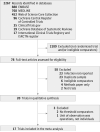Health care-associated infection after red blood cell transfusion: a systematic review and meta-analysis
- PMID: 24691607
- PMCID: PMC4289152
- DOI: 10.1001/jama.2014.2726
Health care-associated infection after red blood cell transfusion: a systematic review and meta-analysis
Erratum in
- JAMA. 2014 Nov 19;312(19):2045
Abstract
Importance: The association between red blood cell (RBC) transfusion strategies and health care-associated infection is not fully understood.
Objective: To evaluate whether RBC transfusion thresholds are associated with the risk of infection and whether risk is independent of leukocyte reduction.
Data sources: MEDLINE, EMBASE, Web of Science Core Collection, Cochrane Central Register of Controlled Trials, Cochrane Database of Sytematic Reviews, ClinicalTrials.gov, International Clinical Trials Registry, and the International Standard Randomized Controlled Trial Number register were searched through January 22, 2014.
Study selection: Randomized clinical trials with restrictive vs liberal RBC transfusion strategies.
Data extraction and synthesis: Twenty-one randomized trials with 8735 patients met eligibility criteria, of which 18 trials (n = 7593 patients) contained sufficient information for meta-analyses. DerSimonian and Laird random-effects models were used to report pooled risk ratios. Absolute risks of infection were calculated using the profile likelihood random-effects method.
Main outcomes and measures: Incidence of health care-associated infection such as pneumonia, mediastinitis, wound infection, and sepsis.
Results: The pooled risk of all serious infections was 11.8% (95% CI, 7.0%-16.7%) in the restrictive group and 16.9% (95% CI, 8.9%-25.4%) in the liberal group. The risk ratio (RR) for the association between transfusion strategies and serious infection was 0.82 (95% CI, 0.72-0.95) with little heterogeneity (I2 = 0%; τ2 <.0001). The number needed to treat (NNT) with restrictive strategies to prevent serious infection was 38 (95% CI, 24-122). The risk of infection remained reduced with a restrictive strategy, even with leukocyte reduction (RR, 0.80 [95% CI, 0.67-0.95]). For trials with a restrictive hemoglobin threshold of <7.0 g/dL, the RR was 0.82 (95% CI, 0.70-0.97) with NNT of 20 (95% CI, 12-133). With stratification by patient type, the RR was 0.70 (95% CI, 0.54-0.91) in patients undergoing orthopedic surgery and 0.51 (95% CI, 0.28-0.95) in patients presenting with sepsis. There were no significant differences in the incidence of infection by RBC threshold for patients with cardiac disease, the critically ill, those with acute upper gastrointestinal bleeding, or for infants with low birth weight.
Conclusions and relevance: Among hospitalized patients, a restrictive RBC transfusion strategy was associated with a reduced risk of health care-associated infection compared with a liberal transfusion strategy. Implementing restrictive strategies may have the potential to lower the incidence of health care-associated infection.
Figures
Comment in
-
Blood transfusion and risk of infection: new convincing evidence.JAMA. 2014 Apr 2;311(13):1293-4. doi: 10.1001/jama.2014.2727. JAMA. 2014. PMID: 24691604 No abstract available.
-
Review: Restrictive RBC transfusion strategies reduce nosocomial infections compared with liberal strategies.Ann Intern Med. 2014 Sep 16;161(6):JC11. doi: 10.7326/0003-4819-161-6-201409160-02011. Ann Intern Med. 2014. PMID: 25222411 No abstract available.
-
Red blood cell transfusion strategies and health care-associated infection.JAMA. 2014 Nov 19;312(19):2041-2. doi: 10.1001/jama.2014.12313. JAMA. 2014. PMID: 25399283 No abstract available.
-
Red blood cell transfusion strategies and health care-associated infection.JAMA. 2014 Nov 19;312(19):2041. doi: 10.1001/jama.2014.12316. JAMA. 2014. PMID: 25399284 No abstract available.
-
Red blood cell transfusion strategies and health care-associated infection--reply.JAMA. 2014 Nov 19;312(19):2042-3. doi: 10.1001/jama.2014.12319. JAMA. 2014. PMID: 25399285 No abstract available.
References
-
- US Department of Health and Human Services [February 4, 2014];National action plan to prevent healthcare-associated infections: roadmap to elimination. http://www.health.gov/hai/prevent_hai.asp. - PubMed
-
- Pronovost P, Needham D, Berenholtz S, et al. An intervention to decrease catheter-related bloodstream infections in the ICU. N Engl J Med. 2006;355(26):2725–2732. - PubMed
-
- Boyce JM, Pittet D. Healthcare Infection Control Practices Advisory Committee; HICPAC/SHEA/ APIC/IDSA Hand Hygiene Task Force; Society for Healthcare Epidemiology of America/Association for Professionals in Infection Control/Infectious Diseases Society of America. Guideline for Hand Hygiene in Health-Care Settings. Recommendations of the Healthcare Infection Control Practices Advisory Committee and the HICPAC/SHEA/ APIC/IDSA Hand Hygiene Task Force. MMWR Recomm Rep. 2002;51(RR-16):1–45. - PubMed
-
- Scott RD. [February 4, 2014];The direct medical costs of health care–associated infections in US hospitals and the benefits of prevention. http://www.cdc.gov/HAI/pdfs/hai/Scott_CostPaper.pdf.
Publication types
MeSH terms
Grants and funding
LinkOut - more resources
Full Text Sources
Other Literature Sources
Medical
Miscellaneous




